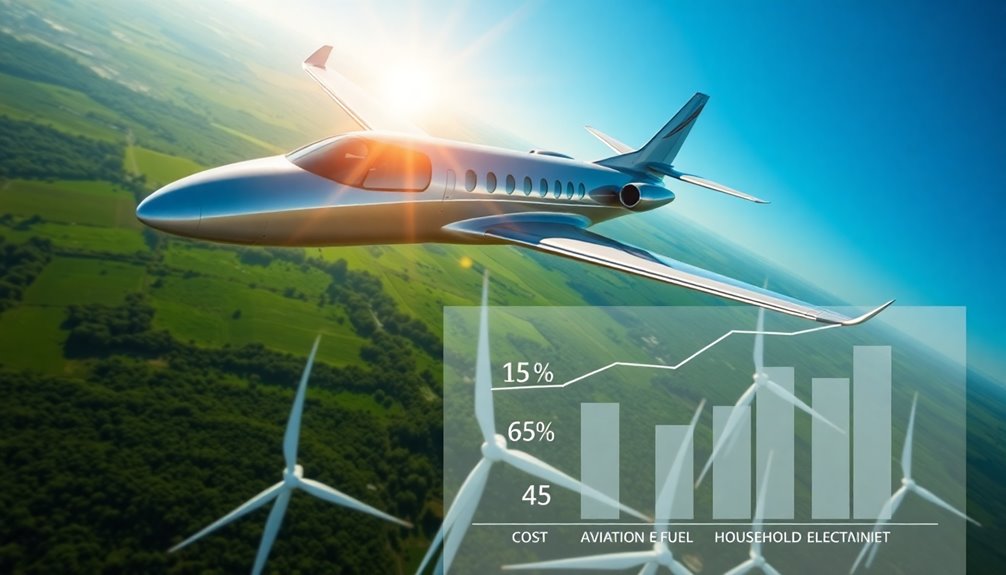Eco-friendly aviation e-fuels cost around 65.5 €/MWh, which is about a third of household electricity at 194 €/MWh. These e-fuels use renewable energy, water, and carbon dioxide to create sustainable aviation options that greatly reduce carbon emissions. They're designed to seamlessly blend with traditional fuels without any need for infrastructure changes. However, the high production costs still pose challenges for widespread use. Discover how ongoing advancements could revolutionize this innovative fuel source.
Key Takeaways
- Current e-fuel electricity costs are approximately 65.5 €/MWh, significantly lower than household electricity costs of 194 €/MWh.
- E-fuels utilize renewable electricity, making them a sustainable option for reducing aviation carbon emissions.
- E-fuels can be blended with conventional fuels up to 50%, facilitating their integration into existing aviation infrastructure.
- The scalability of e-fuels surpasses that of bio-based sustainable aviation fuels, enhancing their potential for widespread adoption.
- Regulatory frameworks like ReFuelEU Aviation are driving investment and interest in e-fuels, aiming for increased blending requirements by 2050.

As the aviation industry grapples with rising emissions and environmental concerns, eco-friendly aviation e-fuels are emerging as a viable solution to reduce carbon footprints. These innovative fuels are produced from renewable electricity, water, and carbon dioxide. Using the Fischer-Tropsch process, e-fuels synthesize hydrogen and carbon dioxide to create hydrocarbon molecules. When sourced from green hydrogen, they can achieve carbon neutrality, making them an attractive option for sustainable air travel.
You might be interested to know that e-fuels offer better scalability compared to bio-based sustainable aviation fuels. This means they can be produced in larger quantities as demand increases. Currently, the cost of e-fuel electricity sits at about 65.5 €/MWh, significantly lower than household electricity, priced at 194 €/MWh. Additionally, the blending of SAF with conventional fuels can reach up to 50%, which highlights the flexibility of e-fuels in the aviation sector.
However, the high production costs of e-fuels still present a challenge, making them more expensive than fossil fuels and most bio-based sustainable aviation fuels. Fortunately, dynamic supply-driven systems have the potential to cut e-fuel production costs by half, improving economic feasibility.
The high production costs of e-fuels pose challenges, but innovative systems could halve these expenses, enhancing their economic viability.
One major advantage of e-fuels is their ability to significantly reduce aviation carbon emissions when used in place of conventional fossil fuels. The drop-in nature of e-fuels allows them to replace fossil fuels without requiring any infrastructure changes, which is a huge plus for the aviation sector.
This production also aids in renewable electricity expansion and grid resilience, helping the transition to clean energy. However, it's crucial to address potential social injustices arising from e-fuel taxation and usage disparities.
With the ReFuelEU Aviation Regulation pushing for a blending of at least 2% sustainable aviation fuel in 2025 and increasing to 6% by 2030, the push for e-fuels is gaining traction. By 2050, the quota for sustainable aviation fuels is expected to reach 70%.
As the industry shifts toward e-fuels, continual technological advancements and investments will enhance their feasibility, paving the way for a greener aviation future.
Frequently Asked Questions
What Are the Main Ingredients for Producing Eco-Friendly Aviation E-Fuels?
To produce eco-friendly aviation e-fuels, you need a few key ingredients.
Hydrogen's essential, created through electrolysis using renewable energy. You'll also require captured carbon dioxide, sourced from biogenic or industrial waste, to combine with hydrogen.
Renewable energy sources like solar, wind, or hydroelectric power are crucial for the process. Lastly, biomass can serve as an alternative ingredient.
These components work together to create sustainable aviation fuels that help reduce environmental impact.
How Do E-Fuels Compare to Traditional Jet Fuels in Terms of Emissions?
You might think e-fuels are just another expensive alternative, but they significantly reduce emissions compared to traditional jet fuels.
E-fuels can cut CO(_2) emissions by up to 94%, and they burn cleaner, producing fewer pollutants like soot.
Plus, they work in existing engines without modifications, making the transition easier.
What Companies Are Currently Developing Eco-Friendly Aviation E-Fuels?
You'll find several companies actively developing eco-friendly aviation e-fuels.
Norsk e-Fuel is working on Project Alby in Sweden, aiming to produce 80,000 tons annually.
Twelve focuses on scaling E-Jet fuel production in Washington State.
Spark e-Fuels just secured funding for a pilot plant in Germany, while RES partners in Project Alby for renewable energy supply.
Additionally, Prime Capital invests strategically in Norsk e-Fuel, driving innovation in sustainable aviation fuel solutions.
Are There Any Government Incentives for Using Aviation E-Fuels?
Think of aviation e-fuels as a bridge to a cleaner future.
Yes, there are several government incentives promoting their use. The Biden Administration's SAF Grand Challenge and FAA grants are paving the way for sustainable aviation fuels.
States like Illinois and Minnesota are providing financial incentives too, offering up to $2 per gallon.
These initiatives help make e-fuels more competitive and encourage production, ultimately leading to a greener aviation industry.
How Long Until Eco-Friendly Aviation E-Fuels Are Widely Adopted?
Widespread adoption of eco-friendly aviation e-fuels is expected in the coming decades, particularly by the late 2030s.
You'll see significant advancements in production technologies and infrastructure improvements that will make e-fuels more cost-competitive with conventional fuels.
As governments and industries form partnerships and implement supportive policies, the transition will accelerate.
Keeping an eye on these developments will help you understand when e-fuels become a mainstream option in the aviation sector.
Conclusion
In conclusion, eco-friendly aviation e-fuels offer a promising path toward sustainable air travel, costing only a third of what you pay for household electricity. Just as a seed planted in fertile soil can grow into a towering tree, investing in these innovative fuels could lead to a greener future for our skies. By embracing these technologies, you're not just reducing your carbon footprint—you're paving the way for a cleaner, more sustainable world for generations to come.









